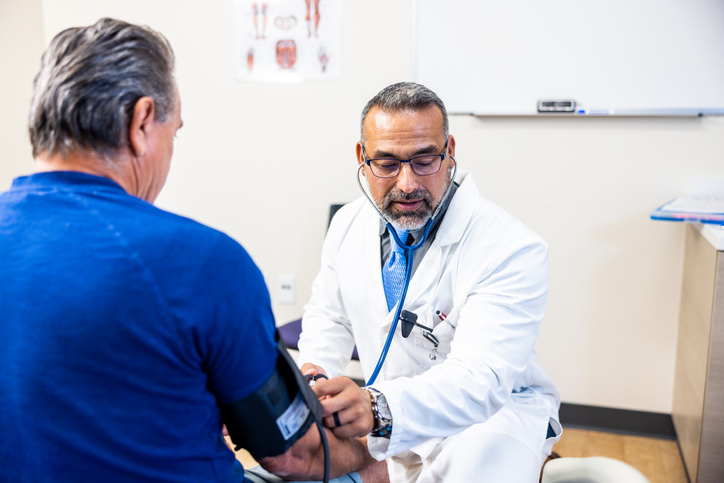Understanding and Preventing High Blood Pressure
Posted December 27, 2023
High blood pressure (or hypertension) is a common but often underestimated health condition affecting millions of people. In fact, the American Heart Association (AHA) reports that nearly half of American adults (48%) have high blood pressure—and only 1 in 4 have their condition under control. This condition puts individuals at risk for heart disease and stroke, which are leading causes of death in the United States.
High blood pressure is a serious medical condition that, if left uncontrolled, can lead to severe complications such as heart disease, stroke and kidney problems. Understanding this condition, its prevalence, risk factors, prevention and management is crucial for maintaining good health.
This article highlights the basics of high blood pressure and tips for prevention and management.
 Blood Pressure Overview
Blood Pressure Overview
Blood pressure is the force exerted by the blood against the walls of the arteries as it is pumped through the body by the heart. It’s typically expressed in two numbers: systolic pressure (the top number) and diastolic pressure (the bottom number). Systolic pressure measures the pressure in the arteries when the heart beats, while diastolic pressure measures the pressure when the heart is at rest between beats. The AHA considers a normal blood pressure reading to be 120/80 millimeters of mercury (mm Hg).
It’s considered high once the blood pressure reading reaches 130/80 mm Hg or above. High blood pressure occurs when the force of the blood against the artery walls is consistently too high, which means the heart and arteries have to work harder than usual. As a result, this condition can damage arteries and increase the risk of serious health problems.
Symptoms
High blood pressure is often referred to as the “silent killer” because it rarely exhibits noticeable symptoms until it reaches a dangerous level. The only way to know whether someone has high blood pressure is by measuring it.
Risk Factors
Several factors increase the risk of developing high blood pressure. Factors that can’t be changed or are difficult to control include:
- Gender (men are more likely to have high blood pressure than women)
- Race/ethnicity (Black adults are more likely to develop this condition)
- Increasing age
- Family history of high blood pressure
- Chronic kidney disease
- Obstructive sleep apnea
Fortunately, some risk factors can be improved or treated, including:
- Being overweight or obese
- Cigarette smoking and exposure to secondhand smoke
- Diabetes
- High cholesterol
- Physical inactivity
- Poor diet that is high in sodium, low in potassium and includes excessive alcohol
Prevention and Management
The good news is that high blood pressure is often preventable and manageable. Consider these tips:
- Adopt a healthy lifestyle. Healthy living includes a balanced diet low in sodium, rich in fruits and vegetables, and low in saturated and trans fats. Engage in regular physical activity, aim for a healthy weight, and avoid smoking and excessive alcohol consumption.
- Limit alcohol. The AHA recommends limiting consumption to no more than two drinks per day for men and one for women.
- Be physically active. Strive to get at least 150 minutes of moderate-intensity physical activity per week, such as brisk walking.
- Reach and maintain a healthy weight. A health care professional can suggest healthy approaches for losing and maintaining weight. For example, they can help you determine how many calories you need for weight loss and advise you on the best activities.
- Get regular checkups. Visit your health care provider regularly for blood pressure checks and follow their recommendations.
- Take medication as prescribed. If lifestyle changes alone are insufficient to control your blood pressure, your doctor may prescribe medication. It’s essential to take prescribed medications as directed.
- Manage stress. Practice stress-reduction techniques such as meditation, yoga or deep breathing exercises to help lower stress, which can contribute to high blood pressure.
- Monitor blood pressure levels. If you have high blood pressure, monitoring your blood pressure at home can help you and your health care provider track your progress and make necessary adjustments to your treatment plan.
It comes down to knowing what your blood pressure should be and trying to keep it at that level. Your doctor can answer any blood pressure questions.
Summary
High blood pressure is a common but potentially serious health condition that affects a significant portion of the U.S. population. Understanding this condition is essential for maintaining good health. By adopting a healthy lifestyle, prioritizing routine health care and following medical advice, individuals can take control of their blood pressure and reduce the risk of developing high blood pressure and associated complications.
Contact a health care professional for a blood pressure reading and to discuss any risk factors or concerns.

 Blood Pressure Overview
Blood Pressure Overview